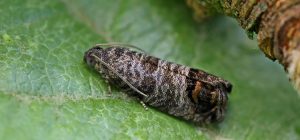Codling Moth Alert
One of the consequences of this year’s unusually warm spring and early summer- pest issues are cropping up earlier than we’ve ever seen them. Most years, we watch our heat units and degree days to properly time a spray for codling moth, one of the common little pests that bores into apples and sometimes pears. In a normal year, our first spray would happen in late June or early July. This year, we hit the magic heat unit number on June 8.
 A little primer on heat units or Degree Days (DD): Most pests have certain temperature ranges when they are active. For codling moth, heat units accumulate when temperatures are between 50° and 88° Fahrenheit. For apple maggot, the models use 44° and 113° Fahrenheit. We look at accumulated degree days in the models to time the sprays.
A little primer on heat units or Degree Days (DD): Most pests have certain temperature ranges when they are active. For codling moth, heat units accumulate when temperatures are between 50° and 88° Fahrenheit. For apple maggot, the models use 44° and 113° Fahrenheit. We look at accumulated degree days in the models to time the sprays.
Using WSU’s No Biofix degree day model for Codling moth, the first expected egg laying happens around 225 DD, which we hit in late April. The first recommended spray should go on at about 525 DD, which we hit June 8. The easiest organic spray for codling moth is Spinosad. Spinosad is available to the homeowner as Monterey Garden Spray and Green Light Bioinsecticide. For the larger grower, it can be purchased as Entrust. Adding 1% summer oil to the tank makes it even more effective by smothering eggs that have not hatched. Spinosad is toxic to bees when wet. Apply early in the morning or late in the evening when bees are not foraging!
Another option if you only have a couple of trees, is to apply maggot barriers now while thinning. Because codling moths are already laying eggs, you may want to spray once before putting the barriers on. The barriers, if you’ve already applied them, they can be 90% effective against codling moth, and 98% effective against apple maggot.
Any fruit that shows sign of infection early (small hole with caterpillar poop at the edges) should be removed from the tree and thrown away. Sanitation in the orchard goes a long way towards keeping pest populations low.

